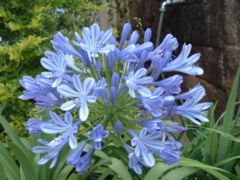Agapanthus: Difference between revisions
No edit summary |
|||
| Line 63: | Line 63: | ||
* ''[[Agapanthus comptonii]]'' | * ''[[Agapanthus comptonii]]'' | ||
* ''[[Agapanthus dyeri]]'' | * ''[[Agapanthus dyeri]]'' | ||
* ''[[Agapanthus 'Headbourne Hybrids']]'' | |||
* ''[[Agapanthus inapertus]]'' (Drakensberg Agapanthus or Drooping Agapanthus) | * ''[[Agapanthus inapertus]]'' (Drakensberg Agapanthus or Drooping Agapanthus) | ||
* ''[[Agapanthus nutans]]'' | * ''[[Agapanthus nutans]]'' | ||
* ''[[Agapanthus orientalis]]'' | * ''[[Agapanthus orientalis]]'' | ||
* ''[[Agapanthus 'Peter Pan']]'' (dwarf) | |||
* ''[[Agapanthus praecox]]'' (Common Agapanthus, Blue Lily, African Lily, or Lily of the Nile) | * ''[[Agapanthus praecox]]'' (Common Agapanthus, Blue Lily, African Lily, or Lily of the Nile) | ||
* ''[[Agapanthus walshii]]'' | * ''[[Agapanthus walshii]]'' | ||
Revision as of 03:43, 22 July 2009
Agapanthus {{{latin_name}}}
|
Lily-of-the-Nile, African blue lily
| ||||||||||||||||||||||||||||||||||||||||
|---|---|---|---|---|---|---|---|---|---|---|---|---|---|---|---|---|---|---|---|---|---|---|---|---|---|---|---|---|---|---|---|---|---|---|---|---|---|---|---|---|---|

|
|
| |||||||||||||||||||||||||||||||||||||||
| |||||||||||||||||||||||||||||||||||||||||
Strap shaped leaves look like a fountain. Flower spikes rise on a stem, with a sphere of flowers on top during summer.
Cultivation
| Agapanthus calendar? | ||
|---|---|---|
| January: | ||
| February: | sow | |
| March: | sow | |
| April: | divide | |
| May: | transplant | |
| June: | ||
| July: | flowering | |
| August: | flowering | |
| September: | flowering | |
| October: | ||
| November: | ||
| December: | ||
| Notes: | ||
Agapanthus africanus can be grown within USDA plant hardiness zones 9 to 11. In lower-numbered zones, the bulbs should be placed deeper in the soil and mulched well in the fall. They can also be dug up and stored indoors during the winter.
Several hundred cultivars and hybrids are cultivated as garden and landscape plants. Several are winter-hardy to USDA Zone 7.
Propagation
Division of bulbs or by seeds. Seeds of most varieties are fertile. Divide once every 5 yearssn.
Pests and diseases
Species
Zonneveld & Duncan (2003) classified Agapanthus into six species (A. africanus, A. campanulatus, A. caulescens, A. coddii, A. inapertus, A. praecox). Four additional taxa recognised by Leighton (1965) as species (A. comptonii, A. dyeri, A. nutans, A. walshii) are given status below species rank by Zonneveld & Duncan.
- Agapanthus africanus (syn. A. umbellatus; African Lily or African Tulip)
- Agapanthus campanulatus (African bluebell, African Blue lily or Bell Agapanthus)
- Agapanthus caulescens
- Agapanthus coddii (Codd's Agapanthus or Blue Lily)
- Agapanthus comptonii
- Agapanthus dyeri
- Agapanthus 'Headbourne Hybrids'
- Agapanthus inapertus (Drakensberg Agapanthus or Drooping Agapanthus)
- Agapanthus nutans
- Agapanthus orientalis
- Agapanthus 'Peter Pan' (dwarf)
- Agapanthus praecox (Common Agapanthus, Blue Lily, African Lily, or Lily of the Nile)
- Agapanthus walshii
Gallery
References
- w:Agapanthus. Some of the material on this page may be from Wikipedia, under the Creative Commons license.
- Agapanthus QR Code (Size 50, 100, 200, 500)
- Manual of Gardening, a Practical Guide to the Making of Home Grounds, L. H. Bailey